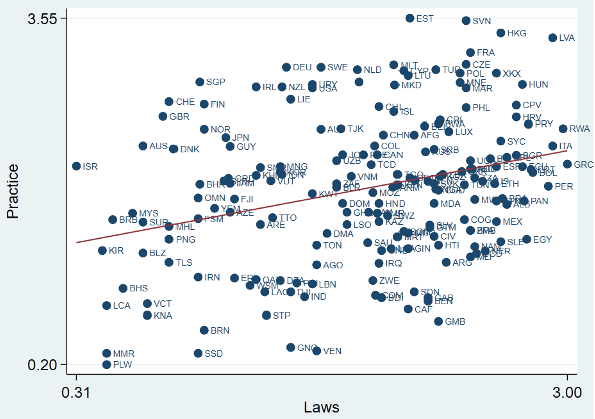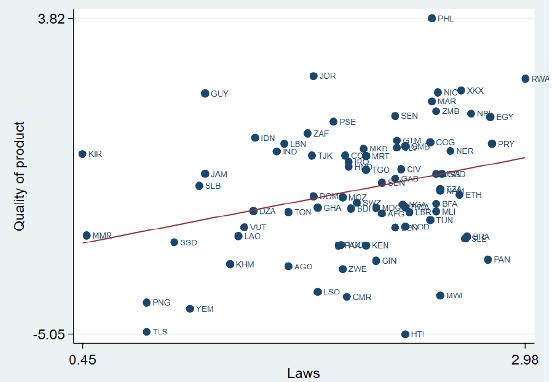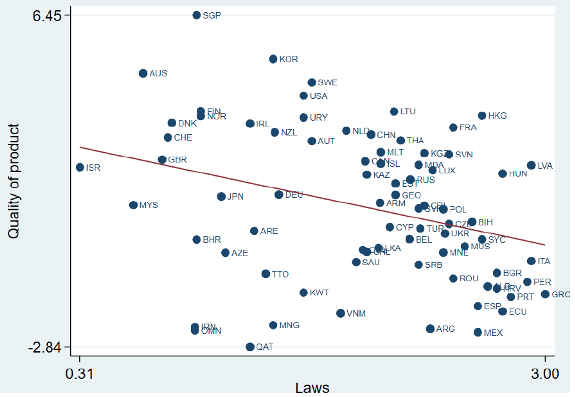_ Erica Bosio, Researcher, World Bank Group; Simeon Djankov, Policy Director, Financial Markets Group, London School of Economics; Edward Glaeser, Fred and Eleanor Glimp Professor of Economics, Harvard University; Andrei Shleifer, John L. Loeb Professor of Economics, Harvard University. 5 November 2020.
Discretion in public procurement allows public officials to pursue socially and economically optimal procurement outcomes, but it also increases the possibility of corruption. This leads to a trade-off between allowing greater discretion and preventing corruption in public procurement. Using survey data on public procurement law and practices from 187 countries in 2019, this column investigates this trade-off. It finds that regulation is helpful when government efficiency is low, and harmful when it is high.
Public procurement is vulnerable to corruption. There is a wide variance in the estimates of bribes in the procurement literature, ranging from 8% to 25% of the value of procured goods, services, or works. Corruption has been found to be common (Di Tella and Schargrodsky 2003, Olken 2007, Collier et al. 2016, Colonnelli and Prem 2020, Lichand and Fernandes 2019), particularly when contracts are renegotiated (Decarolis 2014, Decarolis and Palumbo 2015, Campos et al. 2019).
The high level of discretion that characterises the procurement process is frequently considered the culprit of widespread corruption in this sector. Such discretion has therefore been mitigated through increased regulation, limiting the choices available to procurement agencies. But restricting discretion has a cost as well, in that it prevents public officials from pursuing socially and economically optimal procurement outcomes. It is exactly this trade-off that we investigate in our latest paper.
In Bosio et al. (2020), we analyse public procurement law and practices across 187 countries in 2019. We collected data from public procurement practitioners and lawyers through a standardised questionnaire. The questions covered the entire procurement process for a hypothetical $2.5 million road maintenance project. Respondents in each of the countries (typically eight to twelve professionals, ranging from public procurement lawyers to road construction companies and procuring entities) were presented with a hypothetical $2.5 million road maintenance project. They were asked about the rules that would govern the procurement of such a project. Based on their answers, we constructed measures of laws governing procurement, covering transparency, competition, exclusion of bidders, and integrity of contracts. Respondents also described whether and how procurement practices differed from the laws, which enabled us to create corresponding measures of regulatory practice.
We find that procurement laws predict practices, as shown in Figure 1, meaning that more binding rules are associated with less discretionary practice. In addition, our measures of the less discretionary practice of regulation predict better outcomes. Specifically, procurement practice is correlated with lower levels of corruption, a process index covering favouritism, collusion, lack of competition, a product index gauging cost overruns, time delays, and low quality. However, unlike the procurement practices, procurement laws are not predictive of better outcomes – in other words, regulation in itself is not sufficient to ensure an effective procurement process.
Figure 1 Procurement laws and practices are correlated

Source: Bosio et al. (2020).
To shed light on this puzzle, we propose that public sector capacity shapes the tradeoffs between the costs and benefits of procurement rules. Where capacity is low, bureaucrats will have an incentive to pursue corrupt practices in order to increase bribes. In such situations, by restricting the discretion of the procuring entity, regulation of procurement will have the biggest impact on reducing corruption. In contrast, when public sector capacity is high, limiting procurement discretion will increase costs without reducing corruption. To measure public sector capacity, we use a combination of the World Bank’s Human Capital Index (Angrist et al. 2019) and the World Bank’s Government Effectiveness Indicator.
Our analysis supports this perspective. The impact of procurement laws on reducing the incidence of corruption is higher in countries with a lower government capacity (-0.13, statistically significant at the 5% level), when compared to countries with a higher government capacity (-0.06, statistically significant at the 10% level). Consistent with this view, the data also reveal that there is a statistically significant difference between the mean law index and the mean practice index, when controlling for human capital. In other words, countries with low human capital levels have stricter laws than practices, while the inverse is true for countries with higher human capital levels. This suggests that regulation will not necessarily be translated into better practice in countries with low public sector capacity. Furthermore, we find confirmation in the data for the central argument of our research – namely, that regulation is helpful when government efficiency is low, and harmful when it is high.
We construct an index of the quality of output of the procurement project for our case, based on the surveys of practitioners. As Figures 2 and 3 show, the product index increases with more stringent regulation in countries with low levels of human capital and falls with more regulation in countries characterised by high human capital levels. The evidence points to substantial benefits of regulating procurement, but only in countries with low levels of public sector capacity.
Figure 2 Law and quality of product in low human capital countries

Figure 3 Law and quality of product in high human capital countries

Source: Bosio et al. (2020).
References
Angrist, N, S Djankov, P Goldberg and H Patrinos (2019), “Measuring Human Capital”, World Bank Working Paper No. 8742.
Bosio, E, S Djankov, E Glaeser and A Shleifer (2020), “Public Procurement in Law and Practice”, NBER Working Paper No. 27188.
Campos, N, E Engel, R D Fischer and A Galetovic (2019), “Renegotiations and Corruption in Infrastructure: The Odebrecht Case”, Working paper.
Collier, P and M Kirchberger (2016), “The Cost of Road Infrastructure in Low- and Middle-Income Countries”, World Bank Economic Review 30(3): 522-548.
Colonnelli, E and M Prem (2020), “Corruption and Firms”, Working paper.
Decarolis, F (2014), “Awarding Price, Contract Performance, and Bids Screening: Evidence from Procurement Auctions”, American Economic Journal: Applied Economics 6(1): 108-132.
Decarolis, F and G Palumbo (2015), “Renegotiation of Public Contracts: An Empirical Analysis”, Economics Letters 132(C): 77-81.
Di Tella, R and E Schargrodsky (2003), “The Role of Wages and Auditing During a Crackdown on Corruption in the City of Buenos Aires”, Journal of Law and Economics 46(1): 269–292.
Lichand, G and G Fernades (2019), “The Dark Side of the Contract: Do Government Audits Reduce Corruption in the Presence of Displacement by Vendors?”, University of Zurich, Switzerland, mimeo.
Olken, B (2007), “Monitoring corruption: Evidence from a field experiment in Indonesia”, Journal of Political Economy 115(2): 200-249.
World Bank (2020), Worldwide Governance Indicators, Washington, DC.
Source: https://voxeu.org/
